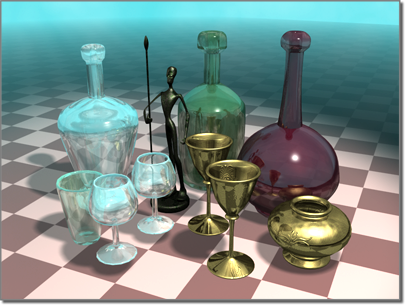Raytrace map provides fully raytraced reflections and refractions. The reflections and refractions it generates are more accurate than those produced by the reflect/refract map. Rendering raytraced objects is slower than using Reflect/Refract. On the other hand, Raytrace is optimized for rendering 3ds Max scenes, and you can further optimize it for your scene by excluding specific objects or effects from raytracing.

Raytrace map creates highly reflective and refractive surfaces.
You can also use the Raytrace material, which uses the same raytracer to generate accurate, raytraced reflections and refractions. The differences between Raytrace map and Raytrace material are:
- You use Raytrace map as you do other maps. This means you can add raytraced reflections or refractions to any kind of material.
- You can assign Raytrace map to material components other than reflect or refract, although these are the main ways to use this map.
- Raytrace map has more extensive attenuation controls than Raytrace material.
- Raytrace map often renders more quickly than Raytrace material.
Raytrace Map and Raytrace material have the same name because they use the same raytracer and share global parameters.
Note: Raytracing does not always work correctly in orthographic viewports (left, front, and so on). It works correctly in perspective viewports and camera viewports.